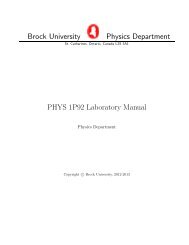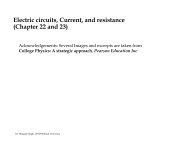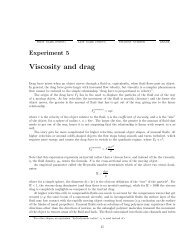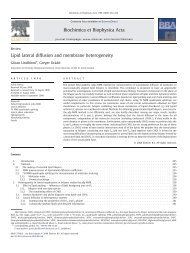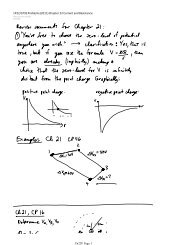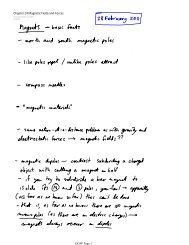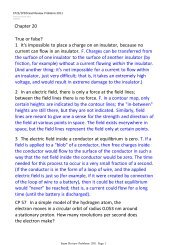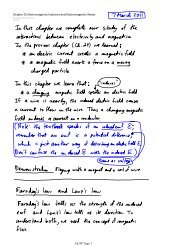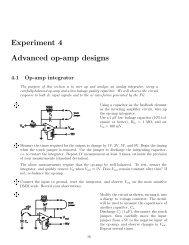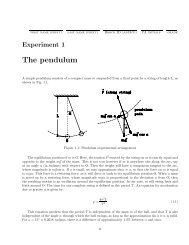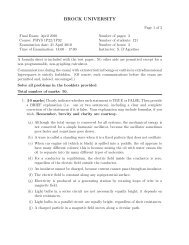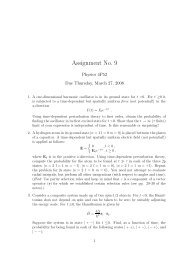You also want an ePaper? Increase the reach of your titles
YUMPU automatically turns print PDFs into web optimized ePapers that Google loves.
<strong>Ch20P</strong> <strong>Page</strong> 1<br />
1P22/1P92 Problems (2011) Chapter 20 Electric Fields and Forces<br />
Sunday, January 09, 2011<br />
4:50 PM<br />
CQ 1 What is alike when we say "two like charges?"<br />
Do they look, feel, or smell alike?<br />
CQ 3 Plastic and glass rods that have been charged by<br />
rubbing with wool and silk, respectively, hang by<br />
threads. (a) An object repels the plastic rod. Can you<br />
predict what it will do to the glass rod? Explain. (b)<br />
Repeat part (a) for an object that attracts the plastic rod.
<strong>Ch20P</strong> <strong>Page</strong> 2
CQ 6 A lightweight metal ball hangs by a thread. When a<br />
charged rod is brought near, the ball moves towards the<br />
rod, touches the rod, then quickly "flies away" from the<br />
rod. Explain.<br />
<strong>Ch20P</strong> <strong>Page</strong> 3
<strong>Ch20P</strong> <strong>Page</strong> 4<br />
CQ 7 Metal sphere A has 4 units of negative charge, and<br />
metal sphere B has 2 units of positive charge. The two<br />
spheres are brought into contact. What is the final charge<br />
state of each sphere?<br />
What is a coulomb?
<strong>Ch20P</strong> <strong>Page</strong> 5<br />
CP 2 A plastic rod has been charged to 20 nC by<br />
rubbing. (a) Have electrons been added or protons<br />
been removed? Explain. (b) How many electrons<br />
have been added or protons removed?<br />
CP 4 A plastic rod that has been charged to 15.0 nC touches<br />
a metal sphere. Afterward, the charge on the rod is 10.0<br />
nC. (a) What kind of charged particle was transferred<br />
between the rod and the sphere, and in which direction?<br />
(b) How many charged particles were transferred?<br />
CP 6 Two identical metal spheres A and B are connected<br />
by a metal rod. Both are initially neutral. Then 1.0 × 10 12<br />
electrons are added to sphere A, then the connecting rod
<strong>Ch20P</strong> <strong>Page</strong> 6<br />
electrons are added to sphere A, then the connecting rod<br />
is removed. Afterward, what is the charge on each sphere?<br />
CQ 12 A metal rod A and a metal sphere B, on insulating<br />
stands, touch each other. They are originally neutral. A<br />
positively charged rod is brought near (but not touching)<br />
the far end of A. While the charged rod is still close, A and<br />
B are separated. The charged rod is then withdrawn. Is the<br />
sphere then positively charged, negatively charged, or<br />
neutral? Explain.
CQ 15 Rank in order, from largest to smallest, noting any ties,<br />
the electric field strengths E1 to E4 at points 1 to 4 in the figure.<br />
<strong>Ch20P</strong> <strong>Page</strong> 7
CP 10 Two small plastic spheres each have a mass of 2.0 g and<br />
a charge of 50.0 nC. They are placed 2.0 cm apart. (a) What is<br />
the magnitude of the electric force between the two spheres?<br />
(b) By what factor is the electric force on a sphere larger than<br />
its weight?<br />
<strong>Ch20P</strong> <strong>Page</strong> 8
CP 14 Determine the magnitude and direction of the force on<br />
charge A in the figure.<br />
<strong>Ch20P</strong> <strong>Page</strong> 9
CP 18 What magnitude charge creates a 1.0 N/C electric field<br />
at a point 1.0 m away?<br />
<strong>Ch20P</strong> <strong>Page</strong> 10
<strong>Ch20P</strong> <strong>Page</strong> 11<br />
CP 20 A 30 nC charged particle and a 50 nC charged particle<br />
are near each other. There are no other charges nearby. The<br />
electric force on the 30 nC particle is 0.035 N. The 50 nC<br />
particle is then moved very far away. Afterward, what is the<br />
magnitude of the electric field at its original position?<br />
CP 22 A +10 nC charge is located at the origin. (a) What are the<br />
strengths of the electric field vectors at the positions (x, y) = (5.0<br />
cm, 0.0 cm), ( 5.0 cm, 5.0 cm), and ( 5.0 cm, 5.0 cm)? (b) Draw<br />
a diagram showing the electric field vectors at these points.
<strong>Ch20P</strong> <strong>Page</strong> 12<br />
CP 26 What is the strength of an electric field that will<br />
balance the weight of a 1.0 g plastic sphere that has<br />
been charged to 3.0 nC?<br />
CP 30 A parallel-plate capacitor is formed from two<br />
4.0 cm × 4.0 cm electrodes spaced 2.0 mm apart. The<br />
electric field strength inside the capacitor is 1.0 × 10 6<br />
N/C. What is the charge in nC on each electrode?
<strong>Ch20P</strong> <strong>Page</strong> 13<br />
N/C. What is the charge in nC on each electrode?<br />
CP 38 A 2.0-mm-diameter copper ball is charged to<br />
+50 nC. What fraction of its electrons have been<br />
removed? Copper has density 8900 kg/m 3 , atomic<br />
mass 63.5 g/mole, and atomic number 29.
<strong>Ch20P</strong> <strong>Page</strong> 14<br />
CP 40 Two protons are 2.0 fm apart. Determine the<br />
magnitude of the (a) electric force and (b) gravitational<br />
force of one proton on the other. (c) Calculate the ratio of<br />
the electric force to the gravitational force and comment.<br />
--- see lecture notes<br />
CP 44 An electric dipole is formed from 1.0 nC point<br />
charges spaced 2.0 mm apart. The dipole is centred at<br />
the origin, oriented along the y-axis. Determine the<br />
electric field strengths at the points (a) (x, y) = (10 mm,<br />
0 mm) and (b) (x, y) = (0 mm, 10 mm).
<strong>Ch20P</strong> <strong>Page</strong> 15
Key Concepts:<br />
<strong>Ch20P</strong> <strong>Page</strong> 16
<strong>Ch20P</strong> <strong>Page</strong> 17<br />
-<br />
-<br />
-<br />
-<br />
-<br />
-<br />
-<br />
-<br />
charge polarization<br />
properties of conductors and insulators<br />
Coulomb's law<br />
principle of superposition<br />
the field concept<br />
electric field patterns for a point charge, a dipole, and a<br />
parallel-plate capacitor<br />
properties of electric field lines<br />
electric field inside and near a conductor<br />
CP 55 The figure shows four charges at the corners of a<br />
square of side L. Assume that q and Q are positive. (a) Draw a<br />
diagram showing the three forces on charge q due to the other<br />
charges. (b) Obtain an expression for the magnitude of the net<br />
force on q.
<strong>Ch20P</strong> <strong>Page</strong> 18
CP 60 Two 2.0-cm-diameter disks face each other, 1.0 mm<br />
apart. They are charged to ±10 nC. (a) Determine the electric<br />
field strength between the disks. (b) A proton is shot from<br />
the negative disk towards the positive disk. What launch<br />
speed must the proton have to just barely reach the positive<br />
disk?<br />
<strong>Ch20P</strong> <strong>Page</strong> 19
<strong>Ch20P</strong> <strong>Page</strong> 20
CP 69 A small bead with a positive charge q is free to slide<br />
on a horizontal wire of length 4.0 cm. At the left end of the<br />
wire is a fixed charge q, and at the right end is a fixed<br />
charge 4q. How far from the left end of the wire does the<br />
bead come to rest?<br />
<strong>Ch20P</strong> <strong>Page</strong> 21
CP 66 An electric field E = (200,000 N/C, right) causes<br />
the 2.0 g ball in the figure to hang at an angle. Calculate<br />
the angle θ.<br />
<strong>Ch20P</strong> <strong>Page</strong> 22
<strong>Ch20P</strong> <strong>Page</strong> 23



